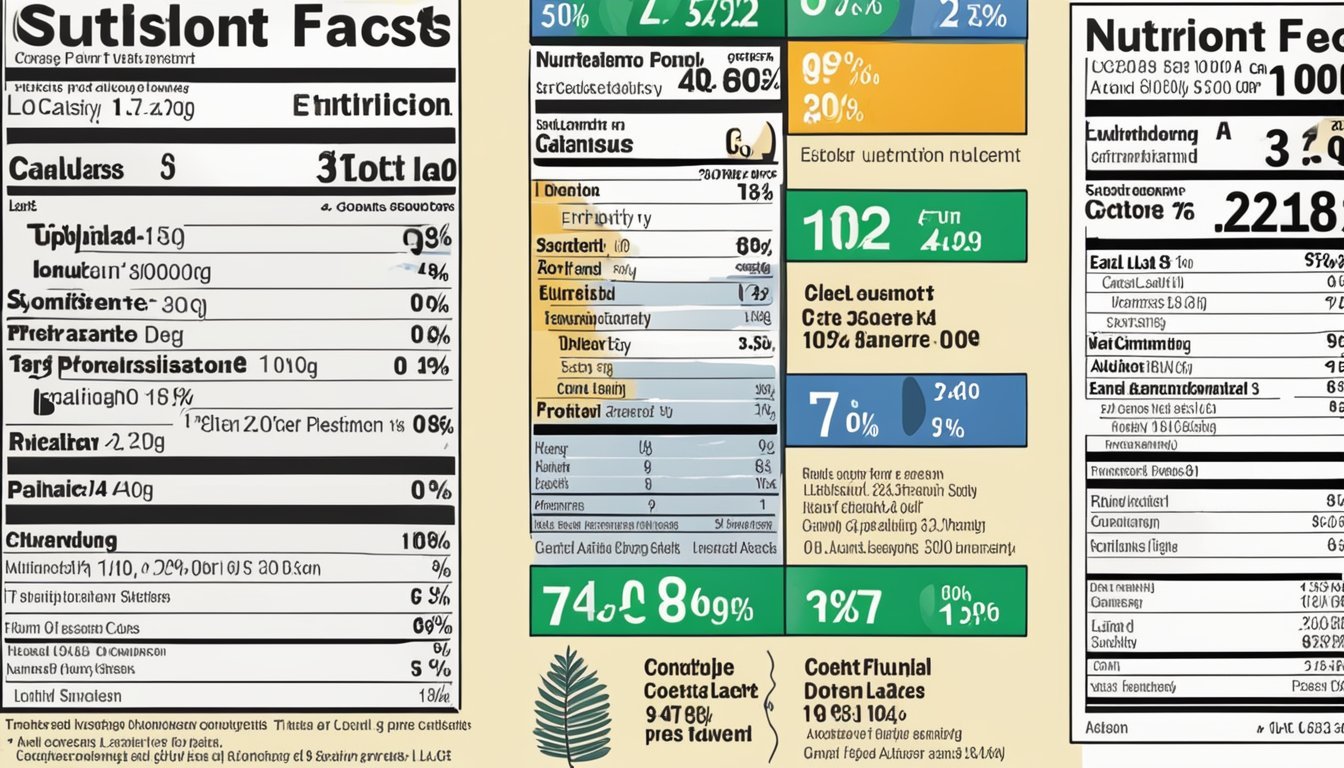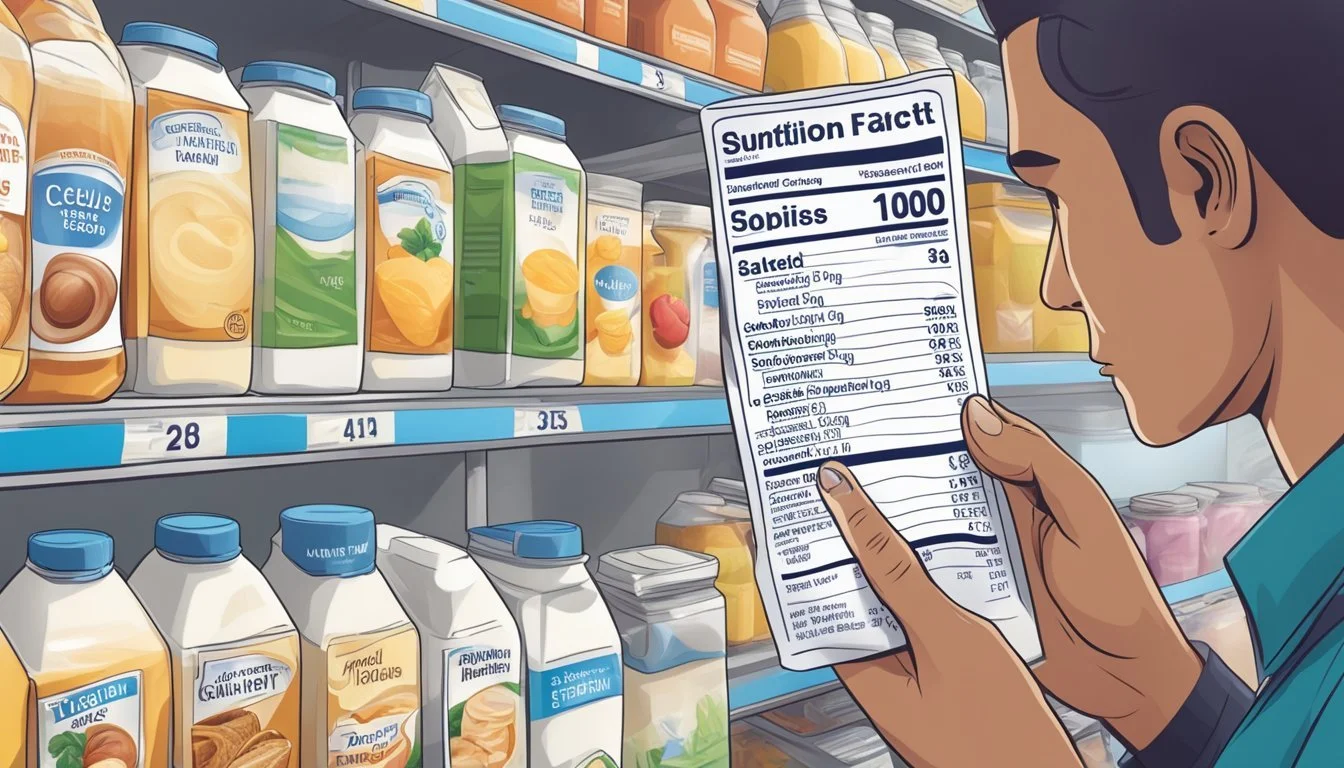How Do I Read Food Labels for Lactose Content?
A Concise Guide
When managing lactose intolerance or a dairy-free diet, understanding how to read food labels for lactose content is crucial. Labels can offer insights into the ingredients and provide an indication of whether a food item contains lactose. To begin, one should examine the ingredient list on a product's packaging, as manufacturers are required to clearly state all components which could include lactose or milk derivatives. Food labels can be particularly helpful as they differentiate between milk-based ingredients and lactose-free options, assists individuals in making informed dietary choices.
Nutrition facts labels are also a valuable resource. They may not explicitly list lactose content, but by looking at the list of ingredients and the nutrition facts panel, those needing to avoid lactose can discern if milk, whey, cream, or milk solids are present—indicating lactose could be in the food. Additionally, understanding the terms "milk-free" and "lactose-free" is important; "milk-free" implies no dairy content at all, whereas "lactose-free" means that while milk proteins may be present, the lactose—the sugar in milk—has been removed.
Learning to interpret these labels empowers consumers to maintain their dietary requirements and avoid the discomfort that can come from consuming lactose unknowingly. However, vigilance is key, as ingredients can change and not all labels may state the lactose content directly. If in doubt, individuals may also need to contact the manufacturer for the most accurate information regarding lactose content.
Understanding Food Labels
When reading food labels, it's crucial to comprehend both the Nutrition Facts Label for nutritional content and the Ingredients List to check for lactose, which is particularly important for those with lactose intolerance or a preference to avoid dairy.
The Basics of a Nutrition Facts Label
The Nutrition Facts Label provides detailed information about the nutritional content of a food item. Key elements include:
Serving Size: This is the amount typically consumed in one sitting, and all the values on the label are based on this portion.
Servings Per Container: Indicates the total number of serving sizes in the entire package.
Calories: Provides a measure of how much energy you get from a serving of the food.
Total Fat: Includes saturated fat and trans fat, which should be consumed in limited amounts.
Cholesterol and Sodium: Monitoring intake of these can be beneficial for heart health.
Total Sugars: Includes both naturally occurring and added sugars.
Fiber: Aids in digestion and can be subtracted from total carbohydrates if counting net carbs.
Vitamins and Minerals: Essential nutrients that the body needs to work properly, often expressed as a % Daily Value (DV).
% Daily Value: Helps determine if a serving of food is high or low in a nutrient; 5% or less is low, 20% or more is high.
The U.S. Food and Drug Administration (FDA) regulates these labels, ensuring standardized information that consumers can use to make informed nutrition decisions.
Identifying Lactose on Ingredients Lists
To identify lactose on food labels, one must review the Ingredients List. Lactose is a sugar found in milk and therefore is present in most dairy products. Look for terms that indicate the presence of lactose, such as:
Milk: The most direct source of lactose.
Whey, Curds, Milk by-products, Dry milk solids, Non-fat dry milk: All often contain lactose.
Cheese, Butter, Cream, Yogurt: Typically have lactose unless specifically labeled as lactose-free.
Nutrition labels must also identify common allergens, including milk, which can help in quickly recognizing if a product may contain lactose. The ingredients list is presented in descending order by weight, so ingredients that appear first are present in larger amounts.
In interpreting these labels, those with lactose intolerance should remember that products labeled as “non-dairy” may still contain lactose, as the term “non-dairy” is not regulated by the FDA in the same way that “dairy-free” is. For complete avoidance, seek products labeled as “lactose-free” or “dairy-free.”
The Importance of Serving Size and Servings Per Container
When reading food labels for lactose content, consumers should pay close attention to the "Serving Size" and "Servings Per Container," as they are critical in managing dietary intake and understanding how much lactose is consumed.
How Serving Sizes Affect Nutrient Intake
The "Serving Size" on a nutrition label indicates the amount of food that is considered a single serving and is based on the Dietary Guidelines for Americans. This information is imperative when tracking nutrient intake. For lactose-intolerant individuals, comparing the serving size to the amount of lactose per serving is essential:
Calories: Calories listed are per serving. Consuming multiple servings increases caloric intake, which is vital for energy balance.
Nutrients: Quantities of nutrients like lactose, are also per serving. Understanding this helps individuals manage specific dietary concerns such as lactose intake, cholesterol levels, and conditions like heart disease or diabetes.
Comparing Servings to Your Daily Diet
"Servings Per Container" informs how many servings are in an entire package, allowing consumers to compare the servings they consume against their daily diet needs. This comparison is vital for maintaining a healthy diet:
Consistency: It aids in aligning the lactose intake from a food product with an individual’s dietary restrictions.
Health Goals: Adherence to daily nutrient limits for lactose can contribute to preventing symptoms associated with lactose intolerance and managing long-term health issues such as high blood pressure.
Consumers should use these label components as a guide to control portion sizes and to make informed decisions that contribute to a nutritionally adequate diet, tailored to their health needs.
Nutrient Content Claims
When examining food labels for lactose content, it's crucial to understand nutrient content claims which provide a snapshot of a food's nutritional profile, indicating if the product is high or low in specific nutrients.
Decoding Labels for Sugar Content
Labels often list sugars under various names, including fructose, glucose, and added sugar. For individuals concerned about lactose, it's important to differentiate between these and natural sugars. Foods marked as "lactose-free" must have less than 0.5 grams of lactose per serving, which is critical for those managing lactose intolerance. The % Daily Value (%DV) can help assess how much a nutrient in a serving of food contributes to a daily diet.
Understanding Fat Content Labels
Fat content on labels is divided into total fat, saturated fats, and trans fat. Trans fat is known to increase low-density lipoprotein (LDL) cholesterol, which can lead to heart disease. While evaluating for lactose content, one should also note that lactose-free products might still contain milk fats, so it's important to read the entire label, especially if managing cholesterol levels.
Recognizing Low/High
Allergen Information and Cross-Contamination
When reading food labels for lactose content, it is essential to understand allergen information and the risk of cross-contamination. This will help those with lactose intolerance or milk allergies to select foods that align with their health needs.
Common Allergens Related to Lactose
The primary allergen related to lactose is milk from cows, though milk from goats, sheep, and other mammals also contains lactose. Products derived from milk, including cheese, butter, and yogurt, inherently contain lactose. Milk is one of the eight major allergens that are required by law to be listed on food labels if they are present in the product. Cross-contamination can occur when lactose-free products come into contact with lactose-containing foods or residues, making vigilance in label reading crucial for those with a lactose allergy or intolerance.
Label Claims and Legal Requirements for Allergens
Food manufacturers are mandated by law, specifically the Food Allergen Labeling and Consumer Protection Act (FALCPA), to list the presence of major food allergens on the nutrition labels. Major food allergens include milk, eggs, fish, shellfish, tree nuts such as almonds, peanuts, wheat, and soybeans. Legal requirements stipulate that allergens must be stated either within the ingredient list or in a separate "contains" statement. Individuals with lactose intolerance or a milk allergy must read labels meticulously for direct mention of milk or milk products, and also for advisory statements regarding potential cross-contamination, such as "made in a facility that also processes milk."
Determining the Presence of Lactose in Various Food Categories
When shopping for foods, it's essential to know how to identify lactose in different product categories by carefully examining nutrition fact labels and ingredient lists.
Dairy and Dairy-Alternative Products
Dairy products, including milk, yogurt, cream, cheese, and butter, typically contain lactose. However, there are variations in lactose content across different types of dairy:
Milk: Regular dairy milk naturally contains lactose, while lactose-free milk is treated with the lactase enzyme to break down lactose.
Cheese: Hard cheeses like cheddar have less lactose because of the fermentation process. Soft cheeses tend to have higher lactose content.
Yogurt: The presence of active cultures can help break down some of the lactose. Greek yogurt often has less lactose compared to traditional yogurt.
Butter and Cream Cheese: These have lower lactose levels but are not completely lactose-free.
Dairy alternatives like soy, almond, or oat milk often do not contain lactose and are suitable for lactose-intolerant individuals.
Pre-packaged Foods and Snacks
Lactose can be an additive in many packaged foods and snacks for its properties as a preservative or to enhance flavor and texture. Consumers should examine labels for ingredients that indicate lactose, such as:
Whey
Milk by-products
Dry milk solids
Milk sugar
Additionally, some products may use non-dairy alternatives, like almonds, peanuts, or soy as ingredients, which do not contain lactose.
Deli and Bakery Items
Deli and bakery items are often sources of hidden lactose. To determine lactose content, one should:
Ask for ingredient lists when possible, as delis and bakeries might use milk, butter, or cheese to prepare their products.
Check for labels or signs that indicate the use of lactose-containing products or cross-contamination with such items.
Items like multigrain bread or organic baked goods can still contain lactose, emphasizing the importance of checking ingredient lists no matter the type of product.
Interpreting Percent Daily Value and Nutrient Density
When reading food labels, understanding Percent Daily Value (%DV) and nutrient density is crucial for identifying how much lactose and other nutrients are in a serving of food, and how these fit into a healthy diet.
What Percent Daily Value Really Means
Percent Daily Value (%DV) on a nutrition facts label indicates the proportion of a nutrient provided in one serving of food in relation to the recommended daily amount. These values are based on the Dietary Guidelines for Americans and assume a daily diet of 2,000 calories. A 5% DV or less per serving is considered low for all nutrients, while a 20% DV or more is considered high. For those managing lactose intake, the %DV can assist in comparing products and making choices that align with their nutritional needs.
- Vitamins and minerals: aim for a higher %DV of nutrients like calcium, vitamin D, potassium, iron, and dietary fiber for good health. - Saturated fat, cholesterol, and sodium: aim for a lower %DV to maintain a healthy diet. - Calories: provide a measure of energy, but not all calories have the same nutritional value.
High Nutrient Foods vs. High Calorie Foods
When assessing foods for lactose content and overall nutritional quality, differentiate between high nutrient foods and high calorie foods. High nutrient foods are rich in essential nutrients compared to their calorie content, contributing to a nutrient-dense diet. They typically contain beneficial nutrients such as dietary fiber, protein, healthy fats, vitamins, and minerals.
Examples of high nutrient foods include: fruits, vegetables, whole grains, lean proteins, and low-fat dairy substitutes.
On the other hand, high calorie foods may offer more energy but contain fewer nutrients, potentially including higher levels of lactose. They may have more added sugars and saturated fats, which can be detrimental to health if consumed in excess.
Examples of high calorie foods include: fast foods, fried foods, pastries, and high-lactose dairy products.
The goal is to balance nutrient content with calorie intake to support a healthy, lactose-conscious diet.
Special Considerations for Dietary Restrictions
When managing dietary restrictions, understanding food labels is essential for maintaining health and avoiding adverse reactions. Accurate label reading allows individuals to identify lactose and other potentially harmful ingredients for those with specific dietary needs.
Adapting Lactose Intolerance Through Label Reading
People with lactose intolerance need to scrutinize food labels to manage their condition effectively. Since lactose is a sugar found in dairy products, those restricted should look for lactose content often listed in the ingredients section. Additionally, it's important to be aware of terms like "whey" or "casein," which indicate the presence of lactose. Products that are labeled as lactose-free are safe options. Some hard cheeses and dairy products may naturally contain lower levels of lactose and could be tolerated in small amounts. However, it's crucial to monitor one's response as tolerance levels can vary.
Here's a quick guide to label reading for lactose content:
Ingredients: Scan for lactose, milk, whey, curds, milk by-products, dry milk solids, nonfat dry milk powder.
Nutrition Labels: Absence of lactose in the carbohydrate section can indicate it is not a significant ingredient.
'Dairy-Free' vs 'Lactose-Free': "Dairy-free" products are devoid of all dairy constituents, while "lactose-free" items may still contain milk proteins.
Navigating Labels for Other Dietary Concerns
Managing other dietary restrictions also requires careful label reading. Those with conditions like heart disease or high cholesterol levels should monitor saturated fat and trans fat content, seeking products with lower percentages of these fats. For individuals with anemia, labels can help find foods high in iron or fortified with this essential mineral.
For those on a special diet, such as a natural or organic regimen, certifications on labels indicate compliance with specific standards. Reading labels also aids those with allergies to avoid trigger ingredients and those with IBS or other digestive issues to find suitable foods that won't exacerbate their conditions. Vegetables, fruits, and whole grains typically do not contain labels, but when they do, being informed about the natural sugars and the benefits of these food groups contributes to a balanced diet and better health.
To monitor electrolyte balance, one should check for sodium content, especially in processed foods. Balancing the intake of potassium and sodium is crucial for maintaining proper electrolyte levels.
Here is a sample table for key nutrients and components to monitor based on various health concerns:
Health Concern Nutrients/Components to Monitor Lactose Intolerance Lactose, Milk Ingredients Heart Disease Saturated Fat, Trans Fat, Cholesterol Levels Anemia Iron (look for "fortified" or "high in iron") Diabetes Total Carbohydrates, Sugars, 'No Sugar Added' High Blood Pressure Sodium, 'Low-Sodium' labels Osteoporosis Calcium, Vitamin D Allergies Specific Allergens (e.g., nuts, gluten)
By applying these strategies, individuals can use nutrition labels as a powerful tool to guide their food choices in accordance with their health and dietary needs.
Practical Tips for Shopping and Meal Planning
Reading food labels is crucial for maintaining good health, especially for those monitoring lactose intake. This section provides specific strategies for quickly identifying appropriate products during grocery shopping and incorporating this knowledge into meal planning.
How to Read Labels Quickly at the Supermarket
When shopping, one should scan the ingredients list for lactose-containing items such as milk, butter, cream cheese, and whey. Products labeled "lactose-free" are suitable for those with lactose intolerance. Here's a quick guide for identifying lactose content:
Look for key words: Scan for "lactose," "milk," or milk derivatives like "butter" or "cream."
Check the allergen statement: Labels often list "contains milk" which indicates lactose presence.
Understand lactose-free labels: "Lactose-free" and "dairy-free" are not the same. "Dairy-free" products are devoid of all dairy components, while "lactose-free" products have the lactose removed but might still contain milk proteins.
Incorporating Food Label Information into Meal Prep
For effective meal planning, understanding the nutrition facts label is essential. It provides information on macronutrients and micronutrients that can help one balance their diet.
Plan with nutrition in mind: Look for foods rich in dietary fiber, minerals, and vitamins. Fruits, vegetables, and whole grains like rice should be a part of the daily diet.
Balance is key: Ensure meals are diverse, considering natural sugars and organic options for snacks.
Consider health guidelines: Refer to the Dietary Guidelines for Americans for recommended nutrient intakes and tailor meals to prevent conditions such as heart disease or manage blood sugar levels.
By incorporating these practical tips during grocery shopping and meal planning, individuals can make informed choices that align with their dietary needs.
Conclusion
Understanding food labels is crucial for individuals managing lactose intolerance. A thorough knowledge of nutrition labels enables consumers to identify lactose in various products, ensuring their health is not compromised. Food labels list all ingredients, and a careful review of these can alert someone to the presence of lactose.
Nutrient sections on food labels are informative; they disclose key factors impacting health, such as fat content, which can indirectly indicate lactose levels—higher fat often means lower lactose. Food labels may also outline the specific types of fat, like saturated and trans fat, but recognizing 'hidden lactose' in products is a learned skill.
In practice, consumers should remember:
To check for ingredients like milk, whey, curds, milk by-products, dry milk solids, and nonfat dry milk powder.
That foods with added fruits or sweet foods such as chocolates and desserts may have varying lactose content.
The importance of being vigilant about 'hidden lactose' in non-dairy products like baked goods and processed meats.
By staying informed and applying this guide to read labels meticulously, those with lactose intolerance can shop with confidence and maintain their dietary health. With practice, they will be able to navigate the plethora of food choices available to them with greater ease and accuracy.






